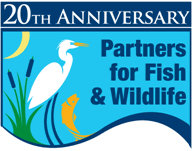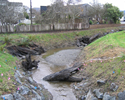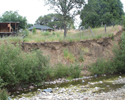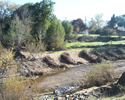|
 The Partners For Fish and Wildlife (Partners) Program
provides financial and technical assistance to private landowners and local partners interested in restoring streams, wetlands, and other native habitat on private property. The program operates on a voluntary basis, relying on interested landowners to provide opportunities for restoration on their lands. Under a cooperative agreement, landowners agree to retain the restoration project for at least ten years but otherwise maintain full control of their land. The Partners For Fish and Wildlife (Partners) Program
provides financial and technical assistance to private landowners and local partners interested in restoring streams, wetlands, and other native habitat on private property. The program operates on a voluntary basis, relying on interested landowners to provide opportunities for restoration on their lands. Under a cooperative agreement, landowners agree to retain the restoration project for at least ten years but otherwise maintain full control of their land.
|
|
| |
|
-
Restore and protect native habitats that provide long-term benefits to Federal trust species, including migratory birds, anadromous fish, threatened or endangered species, and species of special concern
-
Work with partners to identify high-priority restoration projects using the best available scientific information
-
Compliment activities on National Wildlife Refuge System lands, or contribute to projects that will benefit refuge lands
-
Assist partners with applying for other Service funding programs, including the National Coastal Wetlands Grants Program, the North American Waterfowl Conservation Act Program, Private Stewardship Grants, Fish Passage Program, and others.
|
Partners Program Projects :
Highest priority projects are those that restore native habitat and provide long-term benefits to Federal trust species, including anadromous fish, migratory birds, and rare or listed species. Examples of project types include:
Project Types:
-
Returning meanders and floodplain features to straightened stream channels in order to restore natural hydrologic connection and function
-
Building livestock exclusion fencing and off-stream watering systems to allow for restoration of streams and riparian areas
-
Planting native trees and shrubs along riparian corridors and wetland edges
-
Removing exotic plants that alter the natural habitat and compete with native species
-
Improving in-stream fish habitat by placing large woody debris and other cover structures
-
Removing barriers to fish passage. This includes replacing undersized culverts to improve fish passage and hydrologic connection
-
Restoring long-term stream bank stability through bioengineering techniques (e.g. vegetative approaches to stabilizing eroding banks)
-
Restoring wetland and estuarine hydrology by replacing old tide gates, removing or breaching dikes, and re-establishing connection between cut-off swales or side channels
|
|
Eligibility Information:
-
Any non-Federal and non-State land is eligible to receive Partners funds. Funding recipients may include private landowners, tribes, counties, cities, watershed groups, non-profit organizations, and businesses
-
Funding is generally limited to a maximum of $20,000 per project, but greater amounts may be considered
-
The landowner agrees to retain restoration improvements for a minimum of 10 years (but otherwise retains full property rights, including right of trespass). Longer time commitments are encouraged and improve the likelihood of funding
-
There is no minimum cost-share requirement, although projects with a higher cost-share, especially from the landowner, are more competitive. Cost-share may be in-kind (e.g. labor, materials, use of equipment) or monetary.
|
Assistance Process:
-
Contact our Restoration staff to discuss project ideas and to determine program eligibility. After initial discussions and site visits, restoration staff will determine project feasibility and whether the project is a good fit for the program.
-
If the restoration staff determine the project can be supported, then we will work with partners to determine the most appropriate habitat improvements and to develop a comprehensive Project Work Plan. The Project Work Plan will include the final project design, schedule, and budget. Our biologists will work with you to complete the Work Plan as needed.
-
Funding selection will generally be made by May of each year. However, we develop projects year-round, AND funding is limited and discretionary, so don’t wait until the last minute to approach us with project ideas.
|
The Funding and Agreement Process:
After a project is approved for funding, the Recipient must work with our Restoration staff to complete the following in a timely matter:
1. Cooperative Agreement
Program funding is provided to the Recipient through a Cooperative Agreement signed by the Service and the Recipient. This agreement outlines the obligations of each party, terms and conditions, identifies specific project sites and activities, and details reporting requirements and payment procedures. The Service writes the Cooperative Agreement and the applicant reviews and signs it in a timely manner.
2. Wildlife Extension Agreement (Landowner Agreement)
Each participating landowner is required to sign a Wildlife Extension Agreement. The agreement specifies the cost-share and responsibilities of both the landowner and the Service. Under the agreement, the landowner agrees to retain the restoration project for a minimum of 10 years but otherwise retains full private property rights.
3. Permit Process
Prior to the start of the project, the Service is required to ensure that all applicable regulatory requirements have been met. The full permitting process usually takes several months to complete. The Service will provide assistance with completing the appropriate paperwork if needed. Once all the permits have been obtained, the Service authorizes the work to begin. Notification is in the form of a letter.
|
For More Information Contact:
Greg Gray :
Fish and Wildlife Biologist
Partners for Fish and Wildlife Program
U.S. Fish and Wildlife Service
Arcata Fish and Wildlife Office
1655 Heindon Road
Arcata, CA 95521
Phone: 707.822.7201
Fax: 707.822.8411
e-mail: greg_gray@fws.gov
Links:
|
|
|
|
Beith Creek, After |
|
|
Jolly Giant Creek, Before |
Jolly Giant Creek, After |
|
|
Manila Dunes, Before |
Manila Dunes, After |
|
|
Robinson Creek, Before |
Robinson Creek, After |
|
|
|












